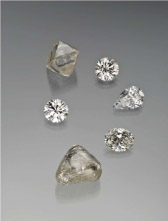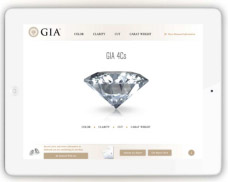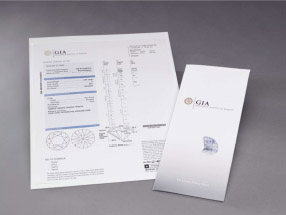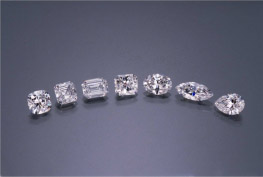Journey of a Diamond

Formed in the depths of the earth for approximately 900 million years, diamonds undergo immense heat, pressure, and other arduous conditions on their way to market. They are the hardest of all gemstones and among the most alluring. Their special characteristics have made diamonds a worldwide symbol of beauty, endurance, and romance.
A well-formed diamond is extremely rare and highly valuable. Diamonds arrive at your local retail store through a lengthy and demanding process. GIA (Gemological Institute of America), the world’s foremost authority on diamonds (as well as coloured gemstones and pearls), plays a significant role in the journey of a diamond from mine to market.
How are diamonds formed?
Gemstone quality diamonds are nearly 100 percent pure carbon, and are the only gemstone mineral made from a single element. They are formed at depths estimated between 125-200 kilometers below the Earth’s surface. The pressure is around 50,000 times greater than the atmospheric pressure at the Earth’s surface, and the temperature range is approximately 900°C to 1300°C.
 Diamond sources across the globe
Diamond sources across the globe
Diamonds require specific geological conditions to form, so they cannot be found everywhere. Southern Africa produces the majority of the world’s diamonds, and they are also produced in Russia, Canada, Australia, India, China and various South American countries.
Mining diamonds
Most diamonds occur in kimberlite pipes in a type of potassic volcanic rock. Two of the most common methods to extract diamonds are open-pit mining and underground mining. Open-pit mining involves large surface excavation, while underground mining is employed for reaching depths no longer economically feasible via the open-pit method. Diamonds are also extracted from alluvial deposits, where they are removed from sand, gravel, or clay along the banks of a river, a shoreline, or an ocean bed.
The right cut
 Before a diamond enters the consumer market, it passes through a cutting manufacturer. India is one of the most important diamond cutting centres in the world, along with Russia, Israel, and Belgium. For hundreds of years, manufacturers used the same basic steps to cut a diamond, but with technology evolving, advanced machines are replacing manual processes. Still, the basic steps of planning, cleaving or sawing, bruting and polishing remain the same.
Before a diamond enters the consumer market, it passes through a cutting manufacturer. India is one of the most important diamond cutting centres in the world, along with Russia, Israel, and Belgium. For hundreds of years, manufacturers used the same basic steps to cut a diamond, but with technology evolving, advanced machines are replacing manual processes. Still, the basic steps of planning, cleaving or sawing, bruting and polishing remain the same.
India as a cutting centre
India cuts approximately 92 percent of the diamonds mined worldwide, and accounts for nearly 65 percent by value. Surat, which had its start processing diamonds from Australia’s Argyle mine, is at the heart of India’s manufacturing. The city now dominates globally as a processing centre, polishing close to 90 percent by volume, and about 57 percent by value. It owes its success to its ability to process a wide range of sizes and qualities.
Final destination
A polished diamond must pass a final inspection before it can be used in jewellery. The diamond is boiled in a solution of hydrochloric and sulfuric acid to cleanse it of oil, diamond powder, and debris, and then is examined to ensure that it meets the manufacturer’s quality standards. Once a diamond passes inspection, it is ready for sale. Jewellers classify the physical attributes of diamonds using the 4Cs of diamond quality--Colour, Cut, Clarity and Carat Weight—as well as the International Diamond Grading System™. Both the 4Cs and the International Diamond Grading System were developed by GIA to objectively compare and evaluate diamonds.
 Carat Weight: The carat is the standard unit of weight for diamonds and other gemstones. The modern metric carat, equal to 0.2 grams, weighs exactly the same in every corner of the world.
Carat Weight: The carat is the standard unit of weight for diamonds and other gemstones. The modern metric carat, equal to 0.2 grams, weighs exactly the same in every corner of the world.
Clarity: Clarity refers to the presence or absence of inclusions in a diamond. The majority of natural inclusions are invisible to the naked eye, yet they affect the way light is reflected and refracted within the stone. Inclusions appear as different shapes, such as crystals, clouds, or feathers.
Colour: The colour grade ranges from “D,” indicating virtually colourless, to “Z,” representing the largest presence of colour. Keep in mind that the closer a diamond is to the colourless end of the scale, the more light it will reflect. Reflected light equals more brilliance.
Cut: Though difficult to analyze or quantify, the cut of any diamond has three attributes: brilliance (the total light reflected from a diamond), fire (the dispersion of light into the colours of the spectrum), and scintillation (the flashes of light, or sparkle, when a diamond is moved).
What is your diamond’s value?
Purchasing a diamond is a sentimental as well as a financial investment. The values you attach to your diamond should guide the worth of your purchase.
 The advancement of gemstone treatments and the constant infusion of synthetics into the market complicate the buying and selling process. These factors highlight the importance of a universally accepted standard for evaluating, documenting and communicating diamond quality. The practical recourse is to use independent diamond grading reports from a trusted third party. A reputable grading report instantly communicates assurance of quality, encourages trust, and helps minimize the perceived risk in making a high-end purchase.
The advancement of gemstone treatments and the constant infusion of synthetics into the market complicate the buying and selling process. These factors highlight the importance of a universally accepted standard for evaluating, documenting and communicating diamond quality. The practical recourse is to use independent diamond grading reports from a trusted third party. A reputable grading report instantly communicates assurance of quality, encourages trust, and helps minimize the perceived risk in making a high-end purchase.
GIA’s International Diamond Grading System, which includes the D-to-Z colour scale, Flawless to I3 clarity scale, and the Excellent to Poor cut scale, provides a universal language for every diamond buyer in the world. GIA is not affiliated with any retailer, wholesaler or manufacturer, which means gem professionals and consumers can rely on GIA reports as the gold standard for objective certification.
Jewellers and retailers selling diamonds must know the value of their products and be able to clearly convey this to their customers. Meanwhile, consumers should play a proactive role by becoming knowledgeable about their intended purchases. Mutual trust and confidence is the key to building a long-lasting relationship between a seller and consumer.
To learn more about GIA services in India, visit www.giaindia.in or e-mail education.giaindia@gia.edu

Various diamond cuts. From left: cushion, square-emerald, emerald, radiant, oval, marquise and pear-cut diamonds. Photograph by Robert Weldon © GIA